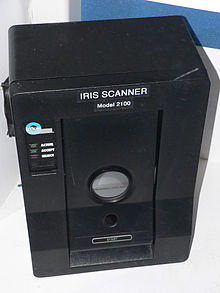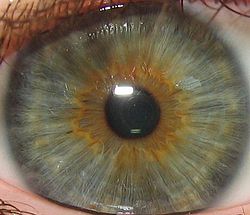
Iris recognition is an automated method of biometric identification that uses mathematical pattern-recognition techniques on video images of the irides of an individual's eyes, whose complex random patterns are unique and can be seen from some distance.
Not to be confused with another, less prevalent, ocular-based technology, retina scanning, iris recognition uses camera technology with subtle infrared illumination to acquire images of the detail-rich, intricate structures of the iris. Digital templates encoded from these patterns by mathematical and statistical algorithms allow the identification of an individual or someone pretending to be that individual.[1] Databases of enrolled templates are searched by matcher engines at speeds measured in the millions of templates per second per (single-core) CPU, and with infinitesimally small false match rates.
Many millions of persons in several countries around the world have been enrolled in iris recognition systems, for convenience purposes such as passport-free automated border-crossings, and some national ID systems based on this technology are being deployed. A key advantage of iris recognition, besides its speed of matching and its extreme resistance to false matches, is the stability of the iris as an internal, protected, yet externally visible organ of the eye.
History
In 1987, two ophthalmology professors, Leonard Flom of New York University and Aran Safir of the University of Connecticut, were issued a first of its kind, broad patent # 4,641,349 entitled "Iris Recognition Technology".[2]
Subsequently, John Daugman of Harvard University was then salaried by both ophthalmologists to write the algorithm for their concept based upon an extensive series of high resolution iris photos supplied to him by Flom from his volunteer private patients.[3] Several years later, Daugman received a method patent for the algorithm and a crudely constructed prototype proved the concept. The three individuals then founded "IriScan" (which later became "Iridian Technologies, Inc.") and assigned the Flom/Safir patent to that entity.
"IriScan" then licensed several corporations to the exclusive Daugman algorithm under the protection of the Flom/Safir broad umbrella patent listed above; thus, preventing other algorithms from competing. Upon expiration of the Flom/Safir patent in 2008 other algorithms were patented and several were found to be superior to Daugman's and are now being funded by U.S. Government agencies.[4]
Visible Wavelength (VW) vs Near Infrared (NIR) Imaging
Most iris recognition systems acquire images of the iris in the visible wavelength (400 - 700 nm) or near infrared range (700 - 900 nm) of the electromagnetic spectrum. Each wavelength distinguishes different features of the iris with NIR and VW obtaining Information from the iris by its texture and pigmentation, respectively. The majority of iris recognition systems operate within the longer NIR spectrum which can penetrate dark-coloured irides, the dominant phenotype of the human population, revealing texture not easily observed in the VW spectrum. The NIR spectrum also reduces iris pattern contamination by blocking ambient corneal reflections.
Although reducing reflections through NIR makes system recognitions robust, NIR imaging cannot distinguish the effects of melanin, the primary colouring component in irides. The melanin, also known as chromophore, mainly consists of two distinct heterogeneous macromolecules, called eumelanin (brown–black) and pheomelanin (yellow–reddish),[5][6] whose absorbance at longer wavelengths in the NIR spectrum is negligible. At shorter wavelengths within the VW spectrum, however, these chromophores are excited and provide rich sources of information mainly coded as shape patterns in iris. Hosseini, et al.[7] provide a comparison between these two imaging modalities and fused the results to boost the recognition rate. An alternative feature extraction method to encode VW iris images was also introduced, which is highly robust to reflectivity terms in iris. Such fusion results are seemed to be alternative approach for multi-modal biometric systems which intend to reach high accuracies of recognition in large databanks.
| Visible Wavelength Iris Image | Near Infrared (NIR) version |
|---|---|
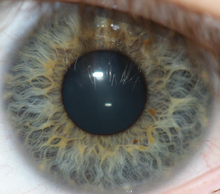 Visible light reveals rich pigmentation details of an Iris by exciting Melanin, the main colouring component in the iris. | 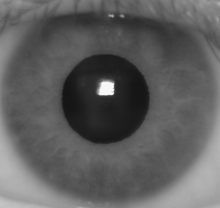 Pigmentation of the Iris is much less visible due to the negligible effects of Melanin at longer wavelengths in the NIR spectrum |
Operating principle
An iris-recognition algorithm first has to localize the inner and outer boundaries of the iris (pupil and limbus) in an image of an eye. Further subroutines detect and exclude eyelids, eyelashes, and specular reflections that often occlude parts of the iris. The set of pixels containing only the iris, normalized by a rubber-sheet model to compensate for pupil dilation or constriction, is then analyzed to extract a bit pattern encoding the information needed to compare two iris images.
In the case of Daugman's algorithms, a Gabor wavelet transform is used. The result is a set of complex numbers that carry local amplitude and phase information about the iris pattern. In Daugman's algorithms, most amplitude information is discarded, and the 2048 bits representing an iris pattern consist of phase information (complex sign bits of the Gabor wavelet projections). Discarding the amplitude information ensures that the template remains largely unaffected by changes in illumination or camera gain (contrast), and contributes to the long-term usability of the biometric template.
For identification (one-to-many template matching) or verification (one-to-one template matching), a template created by imaging an iris is compared to stored template(s) in a database. If the Hamming distance is below the decision threshold, a positive identification has effectively been made because of the statistical extreme improbability that two different persons could agree by chance ("collide") in so many bits, given the high entropy of iris templates.
Advantages
The iris of the eye has been described as the ideal part of the human body for biometric identification for several reasons:
It is an internal organ that is well protected against damage and wear by a highly transparent and sensitive membrane (the cornea). This distinguishes it from fingerprints, which can be difficult to recognize after years of certain types of manual labor. The iris is mostly flat, and its geometric configuration is only controlled by two complementary muscles (the sphincter pupillae and dilator pupillae) that control the diameter of the pupil. This makes the iris shape far more predictable than, for instance, that of the face.
The iris has a fine texture that—like fingerprints—is determined randomly during embryonic gestation. Like the fingerprint, it is very hard (if not impossible) to prove that the iris is unique. However, there are so many factors that go into the formation of these textures (the iris and fingerprint) that the chance of false matches for either is extremely low. Even genetically identical individuals have completely independent iris textures. An iris scan is similar to taking a photograph and can be performed from about 10 cm to a few meters away. There is no need for the person being identified to touch any equipment that has recently been touched by a stranger, thereby eliminating an objection that has been raised in some cultures against fingerprint scanners, where a finger has to touch a surface, or retinal scanning, where the eye must be brought very close to an eyepiece (like looking into a microscope).[8]
The commercially deployed iris-recognition algorithm, John Daugman's IrisCode, has an unprecedented false match rate (better than 10−11 if a Hamming distance threshold of 0.26 is used, meaning that up to 26% of the bits in two IrisCodes are allowed to disagree due to imaging noise, reflections, etc., while still declaring them to be a match).[9] While there are some medical and surgical procedures that can affect the colour and overall shape of the iris, the fine texture remains remarkably stable over many decades. Some iris identifications have succeeded over a period of about 30 years.
Shortcomings
Many commercial iris scanners can be easily fooled by a high quality image of an iris or face in place of the real thing. The scanners are often tough to adjust and can become bothersome for multiple people of different heights to use in succession. The accuracy of scanners can be affected by changes in lighting. Iris scanners are significantly more expensive than some other forms of biometrics, password or prox card security systems
Iris scanning is a relatively new technology and is incompatible with the very substantial investment that the law enforcement and immigration authorities of some countries have already made into fingerprint recognition. Iris recognition is very difficult to perform at a distance larger than a few meters and if the person to be identified is not cooperating by holding the head still and looking into the camera. However, several academic institutions and biometric vendors are developing products that claim to be able to identify subjects at distances of up to 10 meters ("Standoff Iris" or "Iris at a Distance" as well as SRI International's "Iris on the Move" for persons walking at speeds up to 1 meter/sec).[8][10]
As with other photographic biometric technologies, iris recognition is susceptible to poor image quality, with associated failure to enroll rates. As with other identification infrastructure (national residents databases, ID cards, etc.), civil rights activists have voiced concerns that iris-recognition technology might help governments to track individuals beyond their will. Researchers have tricked iris scanners using images generated from digital codes of stored irises. Criminals could exploit this flaw to steal the identities of others.[11]
Alcohol consumption causes recognition degradation as the pupil dilates/constricts causing deformation in the iris pattern.[12]
Security considerations
As with most other biometric identification technology, a still not satisfactorily solved problem with iris recognition is the problem of live-tissue verification. The reliability of any biometric identification depends on ensuring that the signal acquired and compared has actually been recorded from a live body part of the person to be identified and is not a manufactured template. Many commercially available iris-recognition systems are easily fooled by presenting a high-quality photograph of a face instead of a real face, which makes such devices unsuitable for unsupervised applications, such as door access-control systems. The problem of live-tissue verification is less of a concern in supervised applications (e.g., immigration control), where a human operator supervises the process of taking the picture.
Methods that have been suggested to provide some defence against the use of fake eyes and irises include changing ambient lighting during the identification (switching on a bright lamp), such that the pupillary reflex can be verified and the iris image be recorded at several different pupil diameters; analysing the 2D spatial frequency spectrum of the iris image for the peaks caused by the printer dither patterns found on commercially available fake-iris contact lenses; analysing the temporal frequency spectrum of the image for the peaks caused by computer displays.
Other methods include using spectral analysis instead of merely monochromatic cameras to distinguish iris tissue from other material; observing the characteristic natural movement of an eyeball (measuring nystagmus, tracking eye while text is read, etc.); testing for retinal retroreflection (red-eye effect) or for reflections from the eye's four optical surfaces (front and back of both cornea and lens) to verify their presence, position and shape. Another proposed method is to use 3D imaging (e.g., stereo cameras) to verify the position and shape of the iris relative to other eye features.
A 2004 report by the German Federal Office for Information Security noted that none of the iris-recognition systems commercially available at the time implemented any live-tissue verification technology. Like any pattern-recognition technology, live-tissue verifiers will have their own false-reject probability and will therefore further reduce the overall probability that a legitimate user is accepted by the sensor.
Deployed applications
- United Arab Emirates IrisGuard's Homeland Security Border Control has been operating an expellee tracking system in the United Arab Emirates (UAE) since 2001, when the UAE launched a national border-crossing security initiative. Today, all of the UAE's land, air and sea ports of entry are equipped with systems. All foreign nationals who possess a visa to enter the UAE are processed through iris cameras installed at all primary and auxiliary immigration inspection points. To date, the system has apprehended over 330,000 persons re-entering the UAE with fraudulent travel documents.[citation needed]
- Aadhaar, India's Unique ID project for its one billion citizens uses Iris scan as one of the identification features.[citation needed]
- Iris is one of three biometric identification technologies internationally standardized by ICAO for use in future passports (the other two are fingerprint and face recognition).[citation needed]
- Police forces across America plan to start using BI2 Technologies' mobile MORIS (Mobile Offender Recognition and Information System)in 2012. New York City Police Department was the first, installed in Manhattan fall of 2010.[13]
- Iris recognition technology has been implemented by BioID Technologies SA in Pakistan for UNHCR repatriation project to control aid distribution for Afghan refugees. Refugees are repatriated by UNHCR in cooperation with Government of Pakistan, and they are paid for their travel. To make sure people do not get paid more than once, their irises are scanned, and the system will detect the refugees on next attempt. The database has more than 1.3 million iris code templates and around 4000 registrations per day. The one-to-many iris comparison takes place within 1.5 seconds against 1.3 million iris codes.
- At Amsterdam Airport Schiphol, Netherlands, iris recognition has permitted passport-free immigration since 2001.[14]
- Canadian Air Transport Security Authority's Restricted Area Identity Card (RAIC) program is the world's first dual-biometric program deployed around major Canadian airports for staff and aircrews to access the restricted areas using separate channels from passengers.[15][16]
- In a number of US and Canadian airports, as part of the NEXUS program that facilitates entry into the US and Canada for pre-approved, low-risk travelers.[citation needed]
- In several Canadian airports, as part of the CANPASS Air program that facilitates entry into Canada for pre-approved, low-risk air travelers.[17]
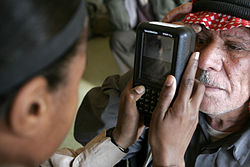
- UK's Iris Recognition Immigration System, which started operating in 2004 but which was closed to new registrations in 2011 and which is being phased out in 2012.[18][19][20]
- Used in 2002 to verify the recognition of the "Afghan Girl" (Sharbat Gula) by National Geographic photographer Steve McCurry.[21]
- In 2010, Leon, Mexico, deployed iris scanners in scan public spaces, where they can identify up to fifty people at once.[23]
- On May 10, 2011, Hoyos Group demonstrated a device called EyeLock using iris-recognition as an alternative to passwords to log people into password-protected Web sites and applications, like Facebook or eBay.[24]
- SRI International Sarnoff has been developing an "Iris on the Move" system and set of products, primarily for U.S. Government clients, capable of identifying 30 people per minute.[10] Most recently, they have specialized in a product where drivers can be identified without needing to leave their vehicle.[25]
Iris recognition in fiction
- In Demolition Man (1993), a character played by Wesley Snipes uses the Warden's gouged eye to gain access through a security door.
- In Dan Brown's 2000 novel Angels and Demons, an assassin gains access to a top secret CERN laboratory using a scientist's eye using retina scan.
- Steven Spielberg's 2002 science fiction film Minority Report depicts a society in which what appears to be a form of iris recognition has become daily practice. The principal character undergoes an eye transplant in order to change his identity but continues to use his original eyes to gain access to restricted locations.[26]
- In The Island (2005), a clone character played by Ewan McGregor uses his eye to gain access through a security door in the home of his DNA donor.
- The Simpsons Movie (2007) features a scene that illustrates the difficulty of image acquisition in iris recognition.[27]
- Numb3rs features a scene where a robber gets into the CalSci facility by cracking the code assigned to a specific iris.
- NCIS uses an iris scanner in the garage, where forensic vehicle investigations are carried out and evidence is stored. There is another scanner at the entrance to MTAC. The sequence of Leroy Jethro Gibbs being verified is shown in the title sequence. The imagery for this sequence has been "enhanced" using special effects. Iris recognition systems do not use the laser like beams shown in the sequence and the light that they do use is near-infrared and nearly invisible.
See also
- Biometric technology in access control
- Iris Recognition Immigration System
- Finger Vein recognition
- Fingerprint recognition
References
- ^ Zetter, Kim (2012-07-25). "Reverse-Engineered Irises Look So Real, They Fool Eye-Scanners". Wired Magazine. Retrieved 25 July 2012.
- ^ "Iris recognition system". Google Patents. Retrieved 2013-07-14.
- ^ "Image Processing: Iris Recognition System Uses Dual Firewire Cameras". Vision Systems Design. May 2009. Retrieved 2013-07-14.
- ^ Marshall, Patrick (2008-01-07). "Authentication in the blink of an eye". GCN. Retrieved 2013-07-14.
- ^ Liu Y, Simon JD (February 2005). "Metal-ion interactions and the structural organization of Sepia eumelanin". Pigment Cell Res. 18 (1): 42–8. doi:10.1111/j.1600-0749.2004.00197.x. PMID 15649151.
- ^ Meredith P, Sarna T (December 2006). "The physical and chemical properties of eumelanin". Pigment Cell Res. 19 (6): 572–94. doi:10.1111/j.1600-0749.2006.00345.x. PMID 17083485.
- ^ Hosseini, M.S.; Araabi, B.N.; Soltanian-Zadeh, H. (April 2010). "Pigment Melanin: Pattern for Iris Recognition". IEEE Trans Instrum Meas 59 (4): 792–804. doi:10.1109/TIM.2009.2037996.
- ^ a b Martin, Zach (2011-03-23). "Biometric Trends: Will emerging modalities and mobile applications bring mass adoption?". SecureIDNews. Retrieved 2013-07-14.
- ^ "Probing the uniqueness and randomness of IrisCodes: Results from 200 billion iris pair comparisons." Proceedings of the IEEE, vol. 94 (11), 2006, pp. 1927-1935.
- ^ a b Terdiman, Daniel (2011-05-05). "SRI shows the benefits of shrinking tech". CNET. Retrieved 2013-07-14.
- ^ "Iris scanners 'can be tricked'".
- ^ Arora, S.S.; Vatsa, M. ; Singh, R. ; Jain, A. "Iris recognition under alcohol influence" (Conference Publications). 978-1-4673-0397-2. Biometrics (ICB), 2012 5th IAPR International Conference on. pp. 336–341. Retrieved March 29, 2012-April 1, 2012.
- ^ "Police to begin iPhone iris scans amid privacy concerns". Reuters. 2011-07-20.
- ^ "Iris scans at Amsterdam Airport Schiphol". Amsterdam Airport Schiphol. Retrieved 2013-07-14.
- ^ "Restricted area identity card".
- ^ "Backgrounder". Canadian Air Transport Security Authority (CATSA).
- ^ CANPASS Air
- ^ "IRIS".
- ^ "Manchester Airport eye scanners scrapped over delays". Manchester Evening News.
- ^ "Airport eye scanners to be reviewed". The Press Association.
- ^ Daugman, John. "How the Afghan Girl was Identified by Her Iris Patterns". University of Cambridge. Retrieved 2013-07-14.
- ^ "Google data center security". Google. 2011-04-13. Retrieved 2013-07-14.
- ^ Saylor, Michael (2012). The Mobile Wave: How Mobile Intelligence Will Change Everything. Perseus Books/Vanguard Press. p. 98. ISBN 978-1593157203.
- ^ Whitney, Lance (2011-05-12). "Iris recognition gadget eliminates passwords". CNET. Retrieved 2011-05-12.
- ^ "SRI International Sarnoff launches iris biometric vehicle access control system". Biometric Update. 2013-04-10. Retrieved 2013-07-15.
- ^ Dolmetsch, Chris (2011-02-01). "'Minority Report' May Come to Real World With Iris Recognition". Bloomberg L.P. Retrieved 2013-07-14.
- ^ Daugman, John. "Iris Recognition and "The Simpsons Movie"". University of Cambridge. Retrieved 2013-07-15.
Further reading
- WO 8605018 Leonard Flom, Aran Safir: Iris recognition system. 28 August 1986; also: US 4641349 issued 2/3/1987.
- US 5291560 John Daugman: Biometric personal identification system based on iris analysis. 1 March 1994
- Daugman, John (January 2004). "How iris recognition works" (PDF). IEEE Transactions on Circuits and Systems for Video Technology 14 (1): 21–30. doi:10.1109/TCSVT.2003.818350.
- Daugman, John (2003). "The importance of being random: statistical principles of iris recognition" (PDF). Pattern Recognition 36 (2): 279–291. doi:10.1016/S0031-3203(02)00030-4.
- Daugman, John (June 2005). "Results from 200 billion iris cross-comparisons". Technical Report UCAM-CL-TR-635. University of Cambridge Computer Laboratory.
- Zhaofeng He, Tieniu Tan, Zhenan Sun and Xianchao Qiu (15 July 2008). "Towards Accurate and Fast Iris Segmentation for Iris Biometrics". IEEE Trans Pattern Anal Mach Intell 31 (9): 1670–84. doi:10.1109/TPAMI.2008.183. PMID 19574626.
- Zhaofeng He, Tieniu Tan, Zhenan Sun and Xianchao Qiu (June 2008). "Boosting Ordinal Features for Accurate and Fast Iris Recognition". Proc. of the 26th IEEE Computer Society Conference on Computer Vision and Pattern Recognition (CVPR'08). pp. 1–8.
- Kaushik Roy, Prabir Bhattacharya (2008). Iris Recognition: A Machine Learning Approach. VDM Verlag Dr. Müller. ISBN 3-639-08259-1.
- K. Roy and P. Bhattacharya (2009). "Variational level set method and game theory applied for nonideal iris recognition". 16th IEEE International Conference on Image Processing (ICIP'09). pp. 2721–4. ISBN 978-1-4244-5653-6.
External links
- Home page of IrisCode designer John Daugman
- ISO/IEC 19794-6 International standard for iris images
- NIST Iris Challenge Evaluation – a contest for competing iris-recognition algorithms
- NIST IREX – a program for various NIST activities supporting interoperable iris biometrics, including comparison of 19 state-of-the-art iris recognition algorithms from 10 providers
- Iris recognition test results, analysis
- Iris recognition algorithm reidentifies Sharbat Gula – Afghan National Geographic cover girl in 1985 – two decades later
- Bath University Iris Image Database
- John G. Daugman's original patent application at USPTO
- World largest current deployment
- Project Iris an Open Source iris recognition system
